 Creative Education 2013. Vol.4, No.7A2, 181-190 Published Online July 2013 in SciRes (http://www.scirp.org/journal/ce) http://dx.doi.org/10.4236/ce.2013.47A2024 Copyright © 2013 SciRes. 181 A Multi-Agent Intelligent Learning System: An Application with a Pedagogical Agent and Learning Objects Sánchez-Guerrero Lourdes1, Laureano-Cruces Ana Lilia1,2,3, Mora-Torres Martha3, Ramírez-Rodríguez Javier1,2, Silva-López Rafaela Blanca1 1Departamento de Sistemas, Universidad Autónoma Metropolitana Azcapotzalco, Distrito Federal, México 2Laboratoire I nformatique d’Avignon, Université d’Avignon et des Pays de Vaucluse, Avignon, France 3Posgrado en Ciencia e Ingeniería de la Computación, Universidad Nacional Autónoma de México, Distrito Federal, México Email: lsg@correo.azc.uam.mx, clc@correo.azc.uam.mx, jararo@correo.azc.uam.mx, rbsl@correo.azc.uam.mx, kabhun@yahoo.com.mx Received May 29th, 2013; revised June 29th, 2013; accepted July 6th, 2013 Copyright © 2013 Sánchez-Guerrero Lourdes et al. This is an open access article distributed under the Creative Commons Attribution License, which permits unrestricted use, distribution, and reproduction in any medium, provided the origina l w o rk is properly cited. This article describes the analysis, design and development of an Intelligent Learning System (ILS). The design of the ILS is based on a multi-agent architecture. This architecture includes reactive agents which represent the expertise of each of the necessary sub-skills in learning the application domain, which in the study case is structured programming. The ILS utilizes artificial intelligence techniques to implement the teaching-learning process using an inference engine based on a general didactic model. As a result, this system is termed as Intelligent Learning System with Learning Objects (ProgEst). ProgEst is carried out with the objective of providing the user with self-regulated learning strategies in addition to the knowl- edge of a determined domain. The case study includes situations related to: learning styles, knowledge domain (errors made) and affective-motivational state. The assessments shall determine: 1) what is to be explained, 2) level of detail and timing, 3) how and when to interrupt the student, and 4) the information to provide during the interaction. Keywords: Intelligent Learning System; Educational Objective; Learning Object Introduction The information and communication technologies of today have evolved rapidly, affecting their application in distinct dis- ciplines. One of the sciences in which they are more frequently being applied is education. At present, a wide variety of elec- tronic media are utilized to send or receive support materials, for the purposes of Distance Education (DE), which has given rise to the e-learning modality. This term refers to the use of new information and communication technologies with a learn- ing objective which involves: 1) the way of organizing educa- tional content; 2) the mode of accessing them; and 3) their use in the teaching and learning process. Intelligent learning system (ILS) with learning objects (LO) (ProgEst) was designed to support students in understanding and learning the skill of pro- gramming. The (LO) model offers a way to build educational content by composition from parts of elements which are located in the lower levels of learning. According to Chan-Núñez, Galeana-de la, Ramírez-Montoya (2006), one of the reasons for which the notion of the LO has gained such strength in the field of information and communi- cations technology (ICT)-based education is the fact that it can be considered as a bridge concept between: education, commu- nication, design and computer sciences, among others. Learning environments are changing rapidly, implying new scenarios that pose technical and pedagogical challenges which higher education institutions must consider in their educational model, and professors, students and support staff must quickly adapt to the use of these new environments. The primary objec- tive of this work lies in combining the new technologies with artificial intelligence (AI) and LO. The following elements were analyzed for the purpose of accomplishing this objective: 1) the pedagogical model used in the didactic materials which are developed, 2) the publication for which the material is cre- ated, and 3) the use of LO. The ILS bases its teaching and learning process in an infer- ence engine inspired by the human tutorial process and is com- prised of the following elements: 1) interest, 2) desire, 3) help, 4) cognitive and operational strategies, 5) interruption, 6) quit- ting, 7) learning, 8) idle time, 9) error 10) student’s perceived tendencies (Laureano-Cruces, Mora-Torres, Ramirez-Rodriguez, de Arriaga-Gómez, & Escarela-Perez, 2010a). These elements are connected in a causal matrix which allows us to see the interconnection of each element with the others. In addition to these elements, learning style is included, which will have a direct impact on the interface and the internal motivation of the object of study. All of these allow selection of the operational  S.-G. LOURDES ET AL. strategies at the appropriate time. The inference engine is rep- resented by extensive cognitive maps, one of the AI techniques used for representation of knowledge with uncertainty and de- sign of the inference engine. The latter is not included in the development of this project (For more information, see Lau- reano-Cruces, Sánchez-Guerrero, Ramirez-Rodriguez, & Mora- Torres, 2008a; Mora-Torres, Laureano-Cruces, & Velasco-San- tos, 2011). On the other hand, the curriculum is designed using a genetic graph, which is based on a multi-agent architecture, implying three expert agents, each one in a sub-domain (Laureano-Cru- ces & de Arriaga-Gómez, 1998; Laureano-Cruces & de Arri- aga-Gómez, 2000; Sanchez-Guerrero, Laureano-Cruces, Mora- Torres, & Ramírez-Rodríguez, 2010). The sub-domains are re- presented by instructional objectives. The aforementioned per- mits the elaboration of a teaching- learning process based on scenarios linked to each one of these sub-domains, and thus allows for detailed error management. For further details, see Reilly & Lewis (1991). The structured programming content was organized based on the LO model, as these offer a way of building educational content by composition based on parts of elements which are located in the lower levels. Likewise, it is a way to search for objects and content, locate, recover and integrate them through a collection of specifications and standards for web based e-learning, or SCORM (Shareable Content Object Reference Model), for their cataloguing, requisition, export, transport and import. Finally, it offers the possibility to build a personalized selection of educational content for each student and moment which offers the optimal context for his or her learning. For greater detail see references (Muñoz-Arteaga, Osorio-Urrutia, Álvarez Rodríguez, & Cardona-Salas, 2008). Chapter 2 ex- plains how the ProgEst system is integrated, chapter 3 explains the example of the use of ProgEst and, finally, we find the con- clusions. ProgEst System ILS’s pose the learning process as cooperation between an intelligent system and humans (Laureano-Cruces, 2000a; Lau- reano-Cruces & de Arriaga-Gómez, 2000b). The tutor, based on the evaluation of the user’s performance, is found within a con- stant decision-making process for the purpose of selecting the most appropriate teaching strategy. These strategies are elabo- rated based on the perception of the user’s performance taking a series of evidence as parameters, such as: errors made, learning style, knowledge domain and affective-motivational state, among others (Pintrich, Smith, García, & Mckeachie, 1991). These assessments determine: what is to be explained, the level of detail and timing, when to interrupt the student and which information to provide during the interaction. An ILS has been designed and implemented together with the learning objects, called ProgEst. An inference engine was utilized to achieve this, based on a general didactic tutor (Lau- reano-Cruces, Teran-Gilmore, & Rodriguez-Aguilar, 2005; Lau- reano-Cruces, Mora-Torres, Ramírez-Rodríguez, & de Arriaga- Gómez, 2011). This is linked to the case study tutor module and to the perceived user performance (student model). The user performance is represented by the student model. The relation- ship between the tutor module and the student model permits creation of the distinct didactic strategies. In the ProgEst system, the cognitive didactic is designed in accordance with the instructional objectives (IO), which re- present the cognitive sub-skills and abilities the professor (in this case, the tutor module) wants to convey to the student (Laureano-Cruces et al., 2000b; Laureano-Cruces, Teran-Gil- more, De Arriaga Gomez, & El Alami, 2003; Laureano-Cruces, et al., 2005). These abilities are activated together with opera- tional didactics (Figure 1). Design of the Agents The mental model generally implies use of the distinct con- trol structures. This point is very important and is part of the detailed logic stage of each module (descending modular pro- gramming and structured programming). Taking this into ac- count and based on the instructional objectives (defined in Sec- tion 3.1), three agents are included: 1) types of data, variables and constants, 2) control structures: (sequence, iteration: condi- tional (during and repeated) and non-conditional (arithmetic progression), selection: simple (if, then, except) and multiple (case dependent)) and 3) abstractions: (procedures, functions) Figure 1. Intelligent learning system (ILS) with learning objects (ProgEst). Copyright © 2013 SciRes. 182 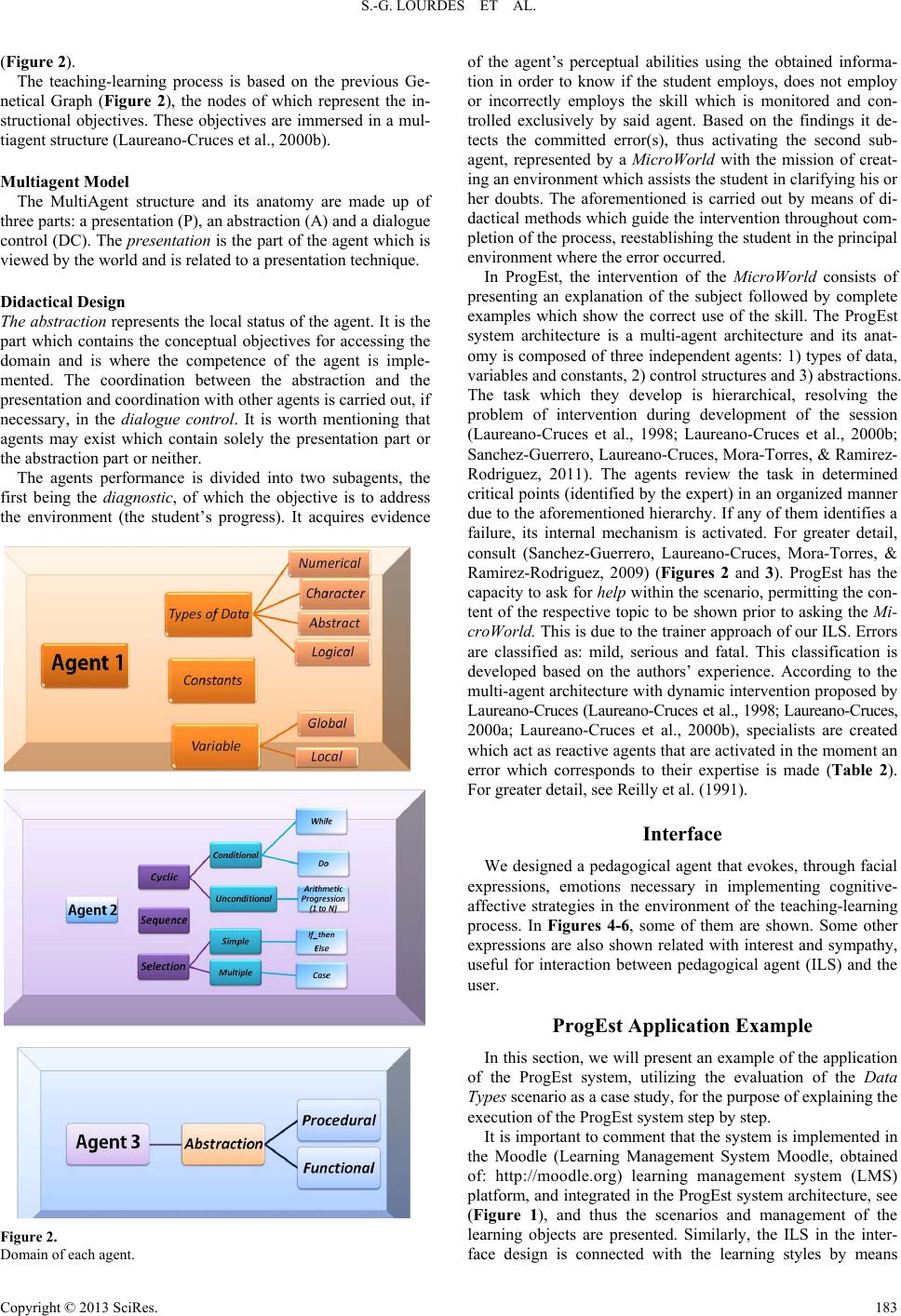 S.-G. LOURDES ET AL. (Figure 2). The teaching-learning process is based on the previous Ge- netical Graph (Figure 2), the nodes of which represent the in- structional objectives. These objectives are immersed in a mul- tiagent structure (Laureano-Cruces et al., 2000b). Multiagent Model The MultiAgent structure and its anatomy are made up of three parts: a presentation (P), an abstraction (A) and a dialogue control (DC). The presentation is the part of the agent which is viewed by the world and is related to a presentation technique. Didactical Design The abstraction represents the local status of the agent. It is the part which contains the conceptual objectives for accessing the domain and is where the competence of the agent is imple- mented. The coordination between the abstraction and the presentation and coordination with other agents is carried out, if necessary, in the dialogue control. It is worth mentioning that agents may exist which contain solely the presentation part or the abstraction part or neither. The agents performance is divided into two subagents, the first being the diagnostic, of which the objective is to address the environment (the student’s progress). It acquires evidence Figure 2. Domain of each agent. of the agent’s perceptual abilities using the obtained informa- tion in order to know if the student employs, does not employ or incorrectly employs the skill which is monitored and con- trolled exclusively by said agent. Based on the findings it de- tects the committed error(s), thus activating the second sub- agent, represented by a MicroWorld with the mission of creat- ing an environment which assists the student in clarifying his or her doubts. The aforementioned is carried out by means of di- dactical methods which guide the intervention throughout com- pletion of the process, reestablishing the student in the principal environment where the error occurred. In ProgEst, the intervention of the MicroWorld consists of presenting an explanation of the subject followed by complete examples which show the correct use of the skill. The ProgEst system architecture is a multi-agent architecture and its anat- omy is composed of three independent agents: 1) types of data, variables and constants, 2) control structures and 3) abstractions. The task which they develop is hierarchical, resolving the problem of intervention during development of the session (Laureano-Cruces et al., 1998; Laureano-Cruces et al., 2000b; Sanchez-Guerrero, Laureano-Cruces, Mora-Torres, & Ramirez- Rodriguez, 2011). The agents review the task in determined critical points (identified by the expert) in an organized manner due to the aforementioned hierarchy. If any of them identifies a failure, its internal mechanism is activated. For greater detail, consult (Sanchez-Guerrero, Laureano-Cruces, Mora-Torres, & Ramirez-Rodriguez, 2009) (Figures 2 and 3). ProgEst has the capacity to ask for help within the scenario, permitting the con- tent of the respective topic to be shown prior to asking the Mi- croWorld. This is due to the trainer approach of our ILS. Errors are classified as: mild, serious and fatal. This classification is developed based on the authors’ experience. According to the multi-agent architecture with dynamic intervention proposed by L aureano -Cruces (Laurea no-Cruces et al., 1998; Laureano-Cruces, 2000a; Laureano-Cruces et al., 2000b), specialists are created which act as reactive agents that are activated in the moment an error which corresponds to their expertise is made (Table 2). For greater detail, see Reilly et al. (1991). Interface We designed a pedagogical agent that evokes, through facial expressions, emotions necessary in implementing cognitive- affective strategies in the environment of the teaching-learning process. In Figures 4-6, some of them are shown. Some other expressions are also shown related with interest and sympathy, useful for interaction between pedagogical agent (ILS) and the user. ProgEst Application Example In this section, we will present an example of the application of the ProgEst system, utilizing the evaluation of the Data Types scenario as a case study, for the purpose of explaining the execution of the ProgEst system step by step. It is important to comment that the system is implemented in the Moodle (Learning Management System Moodle, obtained of: http://moodle.org) learning management system (LMS) platform, and integrated in the ProgEst system architecture, see (Figure 1), and thus the scenarios and management of the learning objects are presented. Similarly, the ILS in the inter- face design is connected with the learning styles by means Copyright © 2013 SciRes. 183 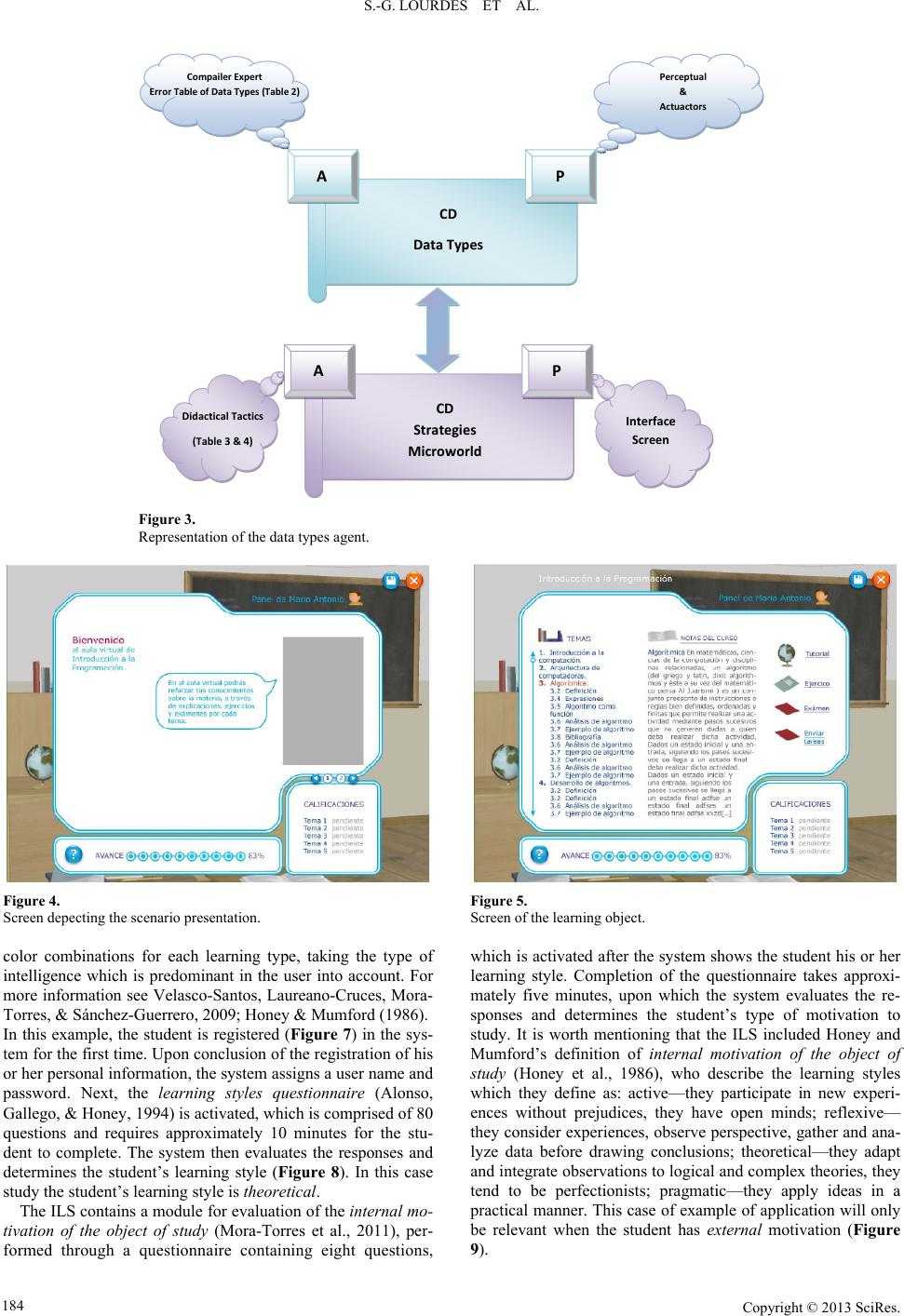 S.-G. LOURDES ET AL. CD DataTypes CompailerExpert ErrorTableofDataTypes(Table2) Perceptual & Actuactors PA CD Strategies Microworld Interfa ce Screen PA DidacticalTactics (Table3&4) Figure 3. Representation of the data types agent. Figure 4. Screen depecting the scenario presentation. color combinations for each learning type, taking the type of intelligence which is predominant in the user into account. For more information see Velasco-Santos, Laureano-Cruces, Mora- Torres, & Sánchez-Guerrero, 2009; Honey & Mumford (1986). In this example, the student is registered (Figure 7) in the sys- tem for the first time. Upon conclusion of the registration of his or her personal information, the system assigns a user name and password. Next, the learning styles questionnaire (Alonso, Gallego, & Honey, 1994) is activated, which is comprised of 80 questions and requires approximately 10 minutes for the stu- dent to complete. The system then evaluates the responses and determines the student’s learning style (Figure 8). In this case study the student’s learning style is theoretical. The ILS contains a module for evaluation of the internal mo- tivation of the object of study (Mora-Torres et al., 2011), per- formed through a questionnaire containing eight questions, Figure 5. Screen of the learning object. which is activated after the system shows the student his or her learning style. Completion of the questionnaire takes approxi- mately five minutes, upon which the system evaluates the re- sponses and determines the student’s type of motivation to study. It is worth mentioning that the ILS included Honey and Mumford’s definition of internal motivation of the object of study (Honey et al., 1986), who describe the learning styles which they define as: active—they participate in new experi- ences without prejudices, they have open minds; reflexive— they consider experiences, observe perspective, gather and ana- lyze data before drawing conclusions; theoretical—they adapt and integrate observations to logical and complex theories, they tend to be perfectionists; pragmatic—they apply ideas in a practical manner. This case of example of application will only be relevant when the student has external motivation (Figure 9). Copyright © 2013 SciRes. 184 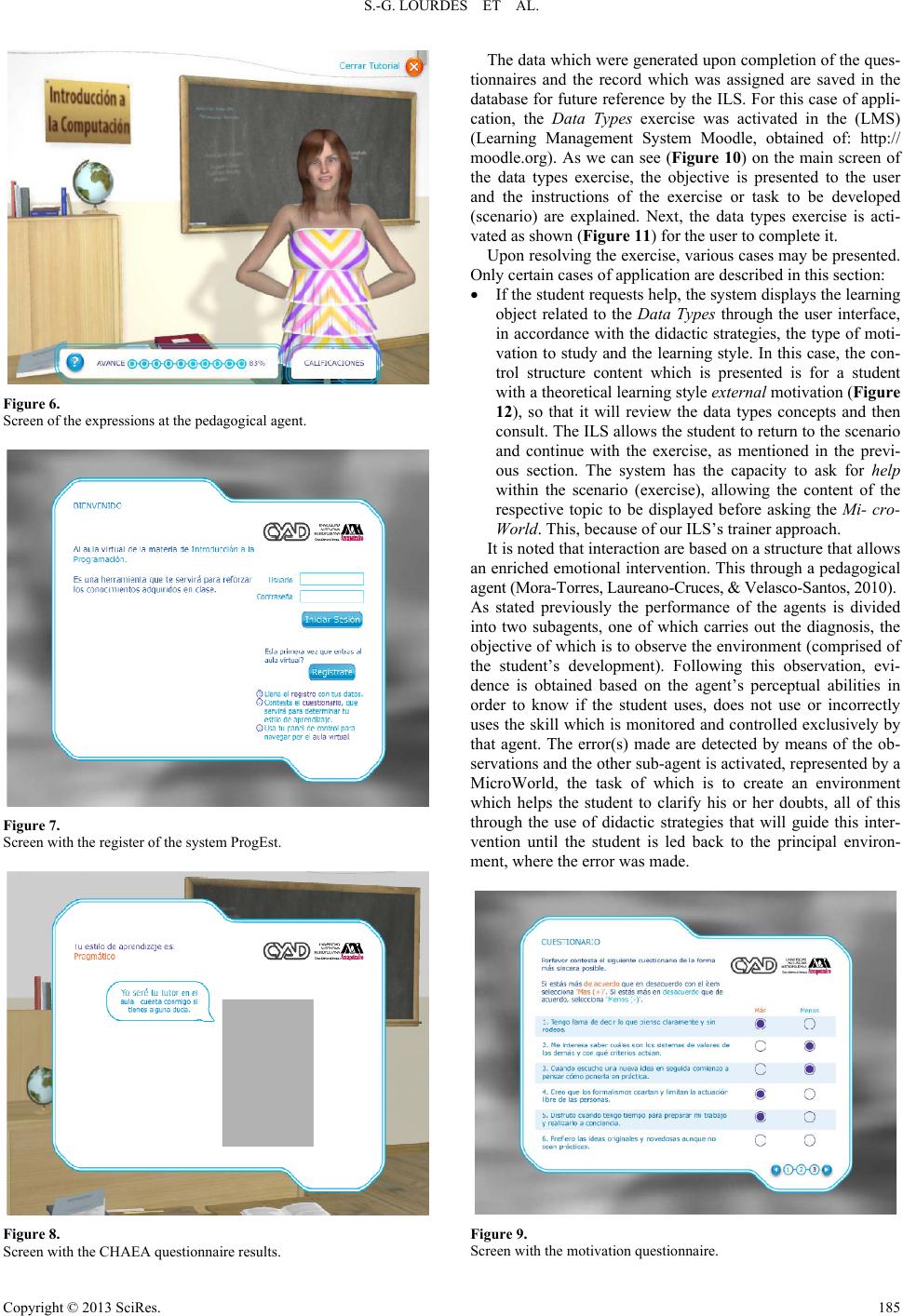 S.-G. LOURDES ET AL. Figure 6. Screen of the expressions at the pedagogical agent. Figure 7. Screen with the register of the system ProgEst. Figure 8. Screen with the CHAEA questionna ire results. The data which were generated upon completion of the ques- tionnaires and the record which was assigned are saved in the database for future reference by the ILS. For this case of appli- cation, the Data Types exercise was activated in the (LMS) (Learning Management System Moodle, obtained of: http:// moodle.org). As we can see (Figure 10) on the main screen of the data types exercise, the objective is presented to the user and the instructions of the exercise or task to be developed (scenario) are explained. Next, the data types exercise is acti- vated as shown (Figure 11) for the user to complete it. Upon resolving the exercise, various cases may be presented. Only certain cases of application are described in this section: If the student requests help, the system displays the learning object related to the Data Types through the user interface, in accordance with the didactic strategies, the type of moti- vation to study and the learning style. In this case, the con- trol structure content which is presented is for a student with a theoretical learning style external motivation (Figure 12), so that it will review the data types concepts and then consult. The ILS allows the student to return to the scenario and continue with the exercise, as mentioned in the previ- ous section. The system has the capacity to ask for help within the scenario (exercise), allowing the content of the respective topic to be displayed before asking the Mi- cro- World. This, because of our ILS’s trainer approach. It is noted that interaction are based on a structure that allows an enriched emotional intervention. This through a pedagogical agent (Mora-Torres, Laureano-Cruces, & Velasco-Santos, 2010). As stated previously the performance of the agents is divided into two subagents, one of which carries out the diagnosis, the objective of which is to observe the environment (comprised of the student’s development). Following this observation, evi- dence is obtained based on the agent’s perceptual abilities in order to know if the student uses, does not use or incorrectly uses the skill which is monitored and controlled exclusively by that agent. The error(s) made are detected by means of the ob- servations and the other sub-agent is activated, represented by a MicroWorld, the task of which is to create an environment which helps the student to clarify his or her doubts, all of this through the use of didactic strategies that will guide this inter- vention until the student is led back to the principal environ- ment, where the error was made. Figure 9. Screen with the motivation questionnaire. Copyright © 2013 SciRes. 185  S.-G. LOURDES ET AL. Figure 10. Principal screen for the exercise of data types agent. Figure 11. Screen for the exercise of data types agent. Figure 12. Screen for the learning object for a student. For management of errors committed by the student, three types of errors were defined in the ILS: mild (M), serious (S) and fatal (F). This is where ProgEst determines the distinct di- dactic strategies to apply depending on the type of error. For this case of application we assume that the student commits an error in the exercise (scenario). For this example, we will apply solely the case of mild errors. Serious errors will be for a student with theoretical type learn- ing with external motivation. For cases where the error is: 1) Mild error (M), imply an overall attention deficit more than a lack of knowledge, that is to say, they possess the spe- cific knowledge and may have used it on previous occasions; nonetheless, due to a lack of attention they become disoriented and fail to complete part of the process. In this case the system verifies which type of learning and motivation the user pos- sesses (external or internal). As the student’s learning type is theoretical and he or she is motivated, the system applies the message We can do it together. You must keep trying! as an operational/cognitive strategy, and permits the student to return to the scenario and continue if and when the number of oppor- tunities has not been used up. 2) Serious error (S), imply a significant lack of conceptuali- zation which leads to failure of the data types application (Fig- ure 13). As this case involves a serious error, the ILS solely allows one opportunity to respond to the exercise, verifies if the motivation is internal or external and applies a cognitive opera- tional strategy, displaying the following phrase through the interface: Let’s continue. You can do it! It activates the data types learning object thorough the Moodle Learning Manage- ment System (LMS), where the student reviews the theoretical information and the control structure application examples. Testing and Results Analysis The ProgEst system was applied to a group of 33 students from the core engineering course at the Universidad Autónoma Metropolitana campus Azcapotzalco. An access code for the system was assigned to each student, each of who completed the questionnaire learning style and internal motivation of the object of study. As shown in the graph, (Figure 14), 51.52% of the group of students has a reflexive learning style, 24.24% is theoretical, 21.21% is pragmatic and solely 3.03% is active. Similarly, we can see in the graph that the internal motiva- tion of the object of study is 42.42% external motivation, 39.39% internal motivation and 18.18% internal-external moti- vation (Figure 15). As aforementioned, the system’s teaching and learning proc- Figure 13. Screen when the student had a serious error with a theoretical learning style external motivation. Copyright © 2013 SciRes. 186 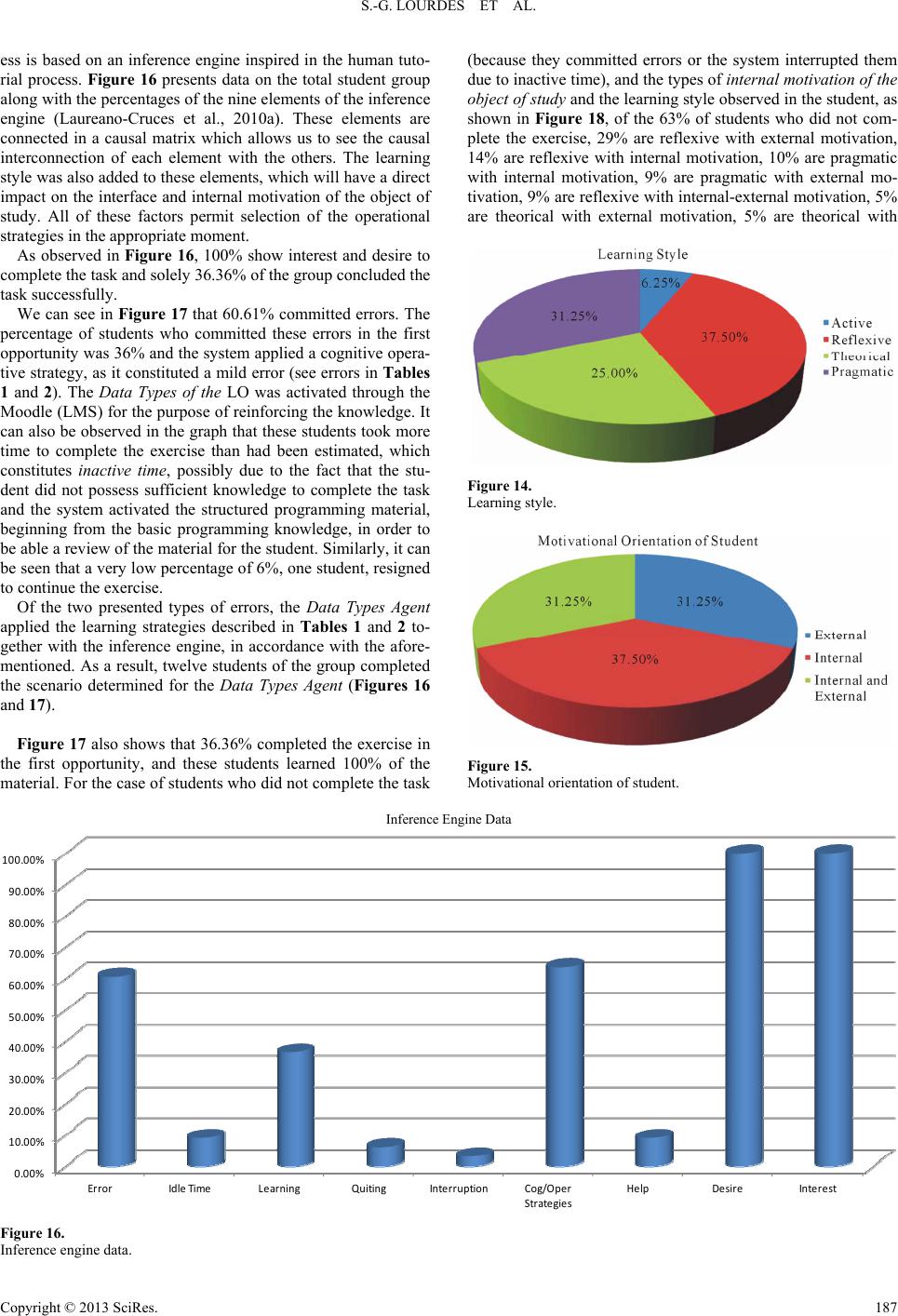 S.-G. LOURDES ET AL. Copyright © 2013 SciRes. 187 ess is based on an inference engine inspired in the human tuto- rial process. Figure 16 presents data on the total student group along with the percentages of the nine elements of the inference engine (Laureano-Cruces et al., 2010a). These elements are connected in a causal matrix which allows us to see the causal interconnection of each element with the others. The learning style was also added to these elements, which will have a direct impact on the interface and internal motivation of the object of study. All of these factors permit selection of the operational strategies in the appropriate moment. (because they committed errors or the system interrupted them due to inactive time ), and th e types of internal motivation of the object of study and the learning style observed in the student, as shown in Figure 18, of the 63% of students who did not com- plete the exercise, 29% are reflexive with external motivation, 14% are reflexive with internal motivation, 10% are pragmatic with internal motivation, 9% are pragmatic with external mo- tivation, 9% are reflexive with internal-external motivation, 5% are theorical with external motivation, 5% are theorical with As observed in Figure 16, 100% show interest and desire to complete the task and solely 36.36% of the group concluded the task successfully. We can see in Figure 17 that 60.61% committed errors. The percentage of students who committed these errors in the first opportunity was 36% and the system applied a cognitive opera- tive strategy, as it constituted a mild error (see errors in Tables 1 and 2). The Data Types of the LO was activated through the Moodle (LMS) for the purpose of reinforcing the knowledge. It can also be observed in the graph that these students took more time to complete the exercise than had been estimated, which constitutes inactive time, possibly due to the fact that the stu- dent did not possess sufficient knowledge to complete the task and the system activated the structured programming material, beginning from the basic programming knowledge, in order to be able a review of the material for the student. Similarly, it can be seen that a very low percentage of 6%, one student, resigned to continue the exercise. Figure 14. Learning style. Of the two presented types of errors, the Data Types Agent applied the learning strategies described in Tables 1 and 2 to- gether with the inference engine, in accordance with the afore- mentioned. As a result, twelve students of the group completed the scenario determined for the Data Types Agent (Figures 16 and 17). Figure 17 also shows that 36.36% completed the exercise in the first opportunity, and these students learned 100% of the material. For the case of students who did not complete the task Figure 15. Motivational orientation o f student. Inference Engine Data 0.00% 10.00% 20.00% 30.00% 40.00% 50.00% 60.00% 70.00% 80.00% 90.00% 100.00% Error IdleTimeLearningQuitingInterruption Cog/Oper Strategie s HelpDesire Interest Figure 16. Inference engine data. 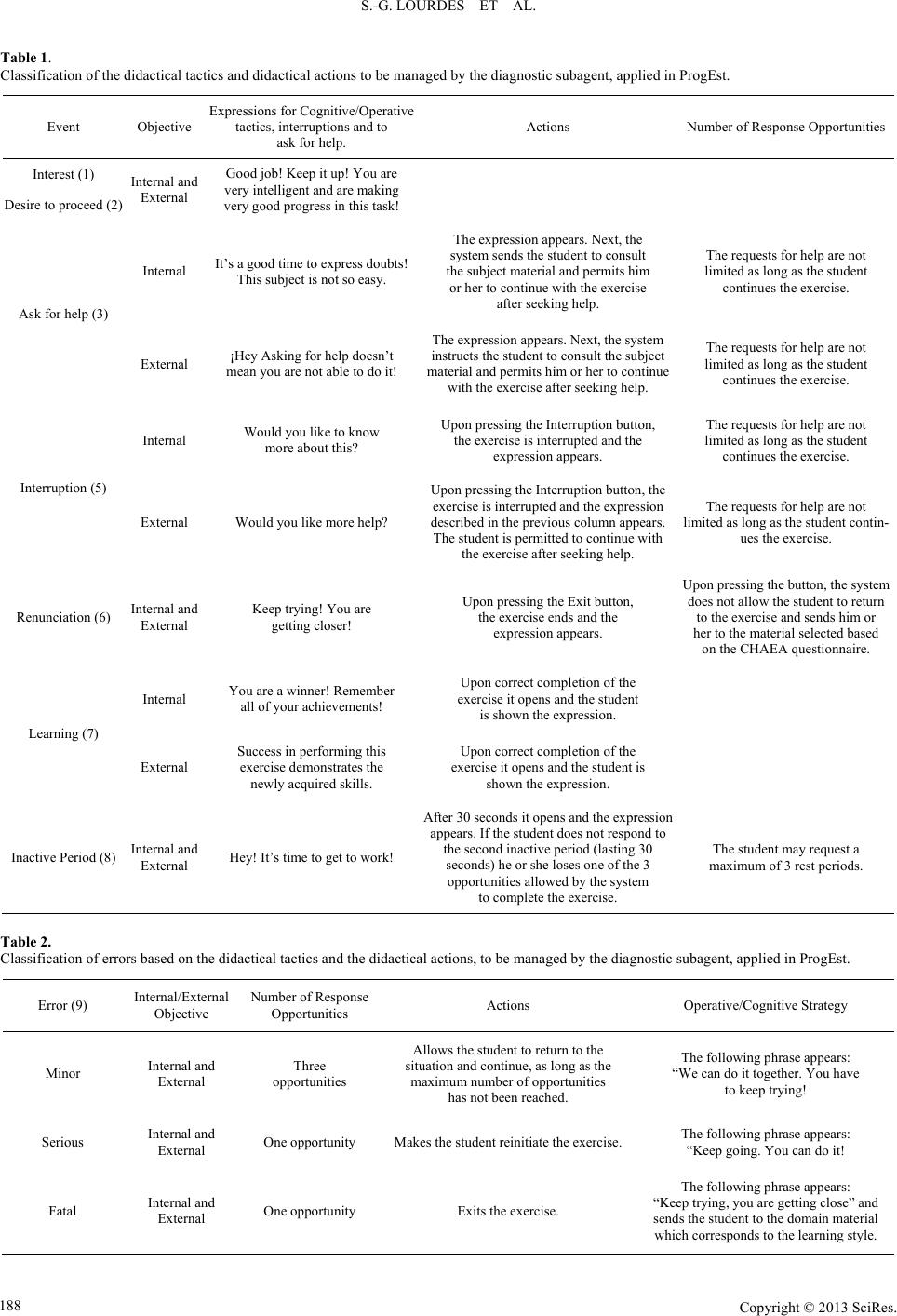 S.-G. LOURDES ET AL. Table 1. Classification of the didactical tactics and didactical actions to b e managed by the diagnostic subagent, applied in ProgEst. Event Objective Expressions for Cognitive/O perative tactics, inter ruptions a n d to ask for help. Actions Number of Response Opportunities Interest (1) Desire to proceed (2) Internal and External Good job! Keep it up! You are very intelligent and are making very good progress i n t his task! Internal It’s a good time to express doubts! This subject is not so easy. The expression appears. Next, the system sends t h e student to consult the subject material and permits him or her to continue with the exerci se after seeking help. The reques ts f or help a r e not limited as long as the student continues the exercise. Ask for help (3) External ¡Hey Askin g for help doe sn’t mean you are not able to do i t! The expression appears. Next, the system instructs the student to consult the subject material and permits him or her to continue with the exercise after seeking help. The reques ts f or help a r e not limited as long as the student continues the exercise. Internal Would you like to know more about this? Upon pressing the Interruption button, the exercise is interrupted and the expression appears. The reques ts f or help a r e not limited as long as the student continues the exercise. Interruption (5) External Would you like more help? Upon pressing the Interruption button, the exercise is interrupted and the expression described in the previous column appears. The student is p ermitted to continue w i th the exercise after seeking help. The reques ts f or help a r e not limited as long as the student c ontin- ues the exercise. Renunciatio n ( 6) Internal and External Keep trying! You are getting closer! Upon pressing the Exit button, the exercise ends and the expression appears. Upon pressing the button, the sys t em does not allow the student to return to the exercise and sends him or her to the m aterial selected based on the CHA EA questionnai re. Internal You are a winner! Remember all of your achievements! Upon correct comple ti on of the exercise it opens and the student is shown the expression. Learning (7 ) External Success in performing this exercise demonstrates the newly ac q ui red skills. Upon correct comple ti on of the exercise it opens and the student is shown the e xp ression. Inactive Period (8) Internal and External Hey! It’s time to get to work! After 30 seconds it opens and the e x pr ession appears. If the student does not respond to the second inactive period (lasting 30 seconds) he or she loses on e of the 3 opportunities allowed by the system to complete the exercise. The student may request a maximum of 3 rest periods. Table 2. Classification of errors based on the d idactical tactics a nd the didactical actions , to be managed by t he diagnostic subagent, applie d i n ProgEst. Error (9) Internal/External Objective Number of Response Opportunities Actions Operative/Cognitive Strategy Minor Internal and External Three opportunities Allows the student to return to the situation and continue, as long a s th e maximum number of opportunities has not bee n r eached. The following phrase appears: “We can do it together. You have to keep trying! Serious I nternal and External One opportunity Makes the stude n t reinitiat e the exercise. The following phrase appears: “Keep goin g. You can do it! Fatal Internal and External One opportunity Exits the exercise. The followi ng phrase appears: “Keep tryi n g, you are getting close” and sends the student to the domain material which corresp onds to the learning style. Copyright © 2013 SciRes. 188  S.-G. LOURDES ET AL. Copyright © 2013 SciRes. 189 Statistics the exercise according to the errors 0.00% 10.00% 20.00% 30.00% 40.00% 50.00% 60.00% 70.00% 80.00% 90.00% 100.00% TaskCompletionLearning 1st.Opportunity 2nd.Opportunity ReviewCourseMaterialIdleTime Quitting Figure 17. Statics the exercise according to the errors. TheoricalStylewith Motivatio nIn te rna ll y 14% TheoricalStylewith Motivatio n Externally 5% Refl e xiv e Stylewith Mo tiv a tion In te rn al l y 14% Refl ex iv e Stylewith Motivatio nExternally 29% Ref le xi ve Stylewith Motiva tion Internal l y and External l y 9% PragmaticStylewith Motivatio nExternal l y 9% PragmaticStylewi th Motiv ati o n Internally 10% PragmaticStylewith Mo tiv a tion In te rn al l yand Exter n al ly 5% TheoricalStylewith Motiv ati o n Internal lyand Ex ternally 5% Task NoCompleted Task Comple ted Figure 18. Students that didn’t conclude the exercise. internal-external motivation and 5% pragmatic with internal- external motivation. As aforementioned, this allows us to con- clude that the majority of the students with external motivation were eliminated from the application by the system because they failed to respond to the questions in the exercise within the time allowed, possibly due to the fact that they needed more examples of data types applications and exercises to understand the di fferent data types. Conclusion The implementation of AI techinques in the development of the ILS by means of the inference engine permits recommenda- tion of distinct strategies, for the purpose of managing the com- plexity of the prediction of didactical strategies in order to strengthen the student’s teaching and learning process, taking the results of the learning styles and motivational orientation questionnaire into account. In this system, the implementation of the inference engine based on a general didactics tutor permits: 1) dynamic interac- tion in the decision-making process in order to select the best educational strategy; 2) predict the possible future status and thus personalize the interactions through the eleven elements which constitute the student model; 3) prevent undesirable states, such as resignation or error, by means of these interac- tions; and 4) develop a specialized method of handling errors caused by reactive agents. An analysis and design methodology has been created, which may be utilized to develop other ILS’s that contain learning objects, through the use of the model de- signed for the general didactic tutor. Nonverbal communication plays an important role in our human relationships, as it influences the other person through expressions and transmitted in-formation on the emotional state of the partners. With this in mind it was considered an avatar (in the case study pedagogical agent) as the appropriate inter- face for ILS-user interaction. The consideration of the avatar (pedagogical agent) is appropriate if the intervention is based on an emotional structure that has been designed according to 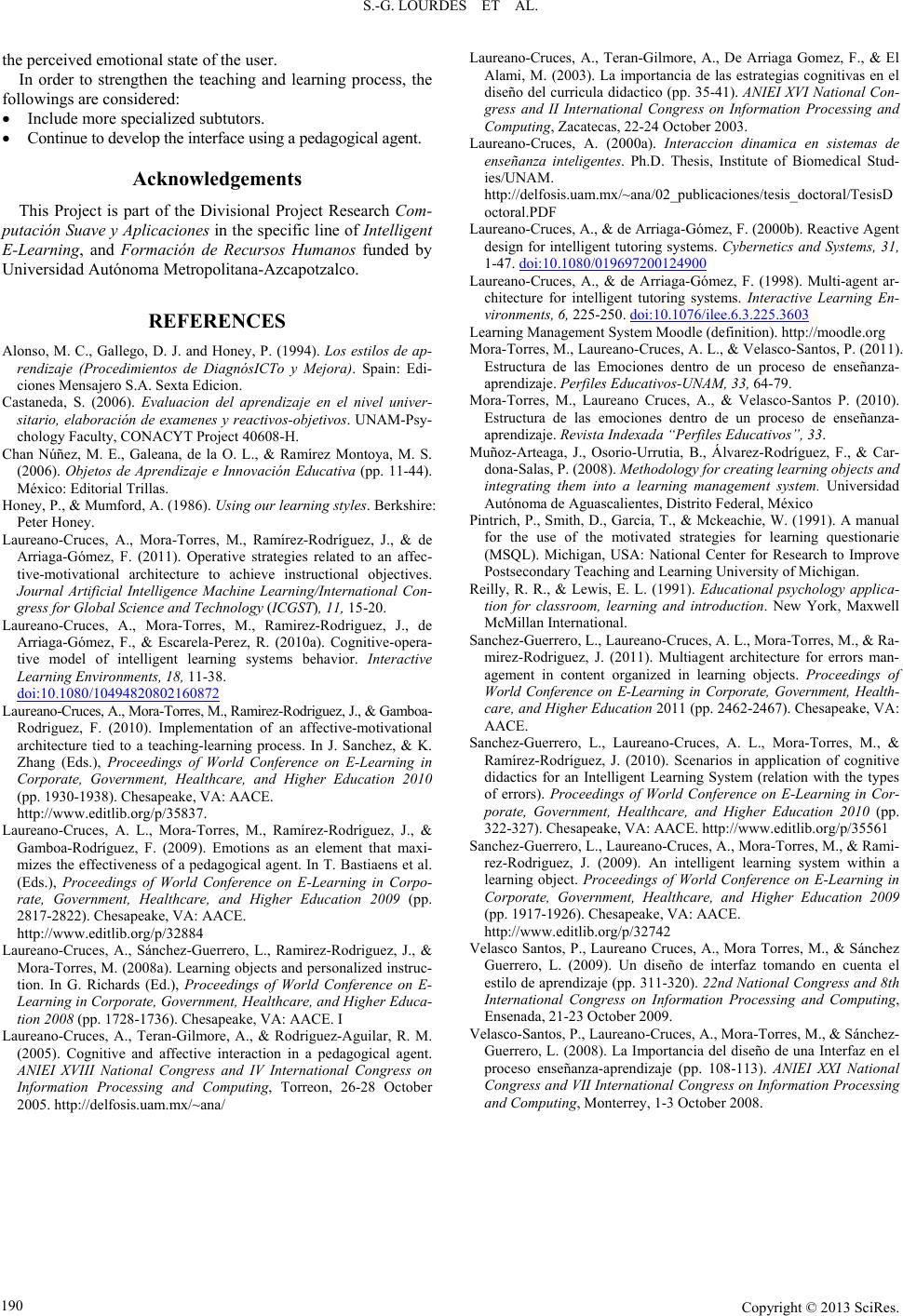 S.-G. LOURDES ET AL. the perceived emotional state of the user. In order to strengthen the teaching and learning process, the followings are considered: Include more specialized subtutors. Continue to develop the interface using a pedagogical agent. Acknowledgements This Project is part of the Divisional Project Research Com- putación Suave y Aplicaciones in the specific line of Intelligent E-Learning, and Formación de Recursos Humanos funded by Universidad Autónoma Metropolitana-Azcapotzalco. REFERENCES Alonso, M. C., Gallego, D. J. and Honey, P. (1994). Los estilos de ap- rendizaje (Procedimientos de DiagnósICTo y Mejora). Spain: Edi- ciones Mensajero S.A. Sexta Edicion. Castaneda, S. (2006). Evaluacion del aprendizaje en el nivel univer- sitario, elaboración de examenes y reactivos-objetivos. UNAM-Psy- chology Faculty, CONACYT Project 40608-H. Chan Núñez, M. E., Galeana, de la O. L., & Ramírez Montoya, M. S. (2006). Objetos de Aprendizaje e Innovación Educativa (pp. 11-44). México: Editorial Trillas. Honey, P., & Mumford, A. (1986). Using our learning styles. Berkshire: Peter Honey. Laureano-Cruces, A., Mora-Torres, M., Ramírez-Rodríguez, J., & de Arriaga-Gómez, F. (2011). Operative strategies related to an affec- tive-motivational architecture to achieve instructional objectives. Journal Artificial Intelligence Machine Learning/International Con- gress for Global Science a nd Technology (ICGST), 11, 15-20. Laureano-Cruces, A., Mora-Torres, M., Ramirez-Rodriguez, J., de Arriaga-Gómez, F., & Escarela-Perez, R. (2010a). Cognitive-opera- tive model of intelligent learning systems behavior. Interactive Learning Environments, 18, 11-38. doi:10.1080/10494820802160872 Laureano-Cruces, A., Mora-Torres, M., Ramirez-Rodriguez, J., & Gamboa- Rodriguez, F. (2010). Implementation of an affective-motivational architecture tied to a teaching-learning process. In J. Sanchez, & K. Zhang (Eds.), Proceedings of World Conference on E-Learning in Corporate, Government, Healthcare, and Higher Education 2010 (pp. 1930-1938) . Chesapeake, VA: AACE. http://www.editlib.org/p/35837. Laureano-Cruces, A. L., Mora-Torres, M., Ramírez-Rodríguez, J., & Gamboa-Rodríguez, F. (2009). Emotions as an element that maxi- mizes the effectiveness of a pedagogical agent. In T. Bastiaens et al. (Eds.), Proceedings of World Conference on E-Learning in Corpo- rate, Government, Healthcare, and Higher Education 2009 (pp. 2817-2822). Chesa p ea ke , VA: AACE. http://www.editlib.org/p/32884 Laureano-Cruces, A., Sánchez-Guerrero, L., Ramirez-Rodriguez, J., & Mora-Torres, M. (2008a). Learning objects and personalized instruc- tion. In G. Richards (Ed.), Proceedings of World Conference on E- Learning in Corporate, Government, Healthcare, and Higher Educa- tion 2008 (pp. 1728-1736). Chesapeake, VA: AACE. I Laureano-Cruces, A., Teran-Gilmore, A., & Rodriguez-Aguilar, R. M. (2005). Cognitive and affective interaction in a pedagogical agent. ANIEI XVIII National Congress and IV International Congress on Information Processing and Computing, Torreon, 26-28 October 2005. http://del fosis.uam.mx/~ana/ Laureano-Cruces, A., Teran-Gilmore, A., De Arriaga Gomez, F., & El Alami, M. (2003). La importancia de las estrategias cognitivas en el diseño del curricula didactico (pp. 35-41). ANIEI XVI National Con- gress and II International Congress on Information Processing and Computing, Zacatecas, 22-24 October 2003. Laureano-Cruces, A. (2000a). Interaccion dinamica en sistemas de enseñanza inteligentes. Ph.D. Thesis, Institute of Biomedical Stud- ies/UNAM. http://delfosis.uam.mx/~ana/02_publicaciones/tesis_doctoral/TesisD octoral.PDF Laureano-Cruces, A., & de Arriaga-Gómez, F. (2000b). Reactive Agent design for intelligent tutoring systems. Cybernetics and Systems, 31, 1-47. doi:10.1080/019697200124900 Laureano-Cruces, A., & de Arriaga-Gómez, F. (1998). Multi-agent ar- chitecture for intelligent tutoring systems. Interactive Learning En- vironments, 6, 225-250. doi:10.1076/ilee.6.3.225.3603 Learning Management System Moodle (definition). http:/ /moodle.org Mora-Torres, M., Laureano-Cruces, A. L., & Velasco-Santos, P. (2011). Estructura de las Emociones dentro de un proceso de enseñanza- aprendizaje. Perfiles Educativos-U N AM, 33, 64-79. Mora-Torres, M., Laureano Cruces, A., & Velasco-Santos P. (2010). Estructura de las emociones dentro de un proceso de enseñanza- aprendizaje. Revista Indexada “Perfiles Educativos”, 33. Muñoz-Arteaga, J., Osorio-Urrutia, B., Álvarez-Rodríguez, F., & Car- dona-Salas, P. (2008). Me thodology for creating learning objects and integrating them into a learning management system. Universidad Autónoma de Aguasca lientes, Distrito Federal, México Pintrich, P., Smith, D., García, T., & Mckeachie, W. (1991). A manual for the use of the motivated strategies for learning questionarie (MSQL). Michigan, USA: National Center for Research to Improve Postsecondary Teac h i n g a n d Learning University of Michigan. Reilly, R. R., & Lewis, E. L. (1991). Educational psychology applica- tion for classroom, learning and introduction. New York, Maxwell McMillan International. Sanchez-Guerrero, L., Laureano-Cru ces, A. L., Mora -To rres, M., & Ra- mirez-Rodriguez, J. (2011). Multiagent architecture for errors man- agement in content organized in learning objects. Proceedings of World Conference on E-Learning in Corporate, Government, Health- care, and Higher Education 2011 (pp. 2462-2467). Chesapeake, VA: AACE. Sanchez-Guerrero, L., Laureano-Cruces, A. L., Mora-Torres, M., & Ramírez-Rodríguez, J. (2010). Scenarios in application of cognitive didactics for an Intelligent Learning System (relation with the types of errors). Proceedings of World Conference on E-Learning in Cor- porate, Government, Healthcare, and Higher Education 2010 (pp. 322-327). Chesapeake, VA: AACE. http://www.editlib.org/p/35561 Sanchez-Guerrero, L., Laureano-Cruces, A., Mora-Torres, M., & Rami- rez-Rodriguez, J. (2009). An intelligent learning system within a learning object. Proceedings of World Conference on E-Learning in Corporate, Government, Healthcare, and Higher Education 2009 (pp. 1917-1926) . Chesapeake, VA: AACE. http://www.editlib.org/p/32742 Velasco Santos, P., Laureano Cruces, A., Mora Torres, M., & Sánchez Guerrero, L. (2009). Un diseño de interfaz tomando en cuenta el estilo de aprendizaje (pp. 311-320). 22nd National Congress and 8th International Congress on Information Processing and Computing, Ensenada, 21-23 October 2009. Velasco-Santos, P., Laure a no -Cru ces, A., Mora-Torres, M., & Sánchez- Guerrero, L. (2008). La Importancia del diseño de una Interfaz en el proceso enseñanza-aprendizaje (pp. 108-113). ANIEI XXI National Congress and VII International Congress on Information Processing and Computing, Monterrey, 1-3 October 2008. Copyright © 2013 SciRes. 190
|